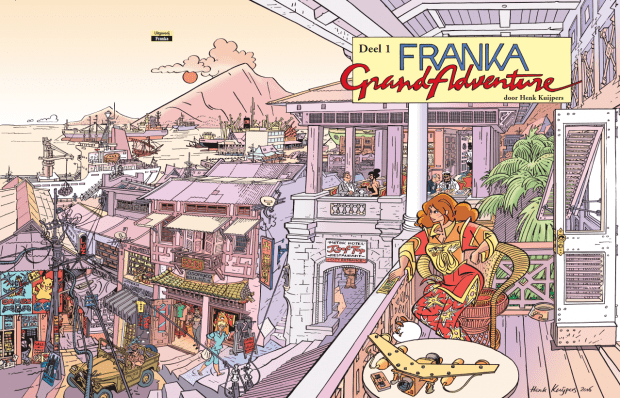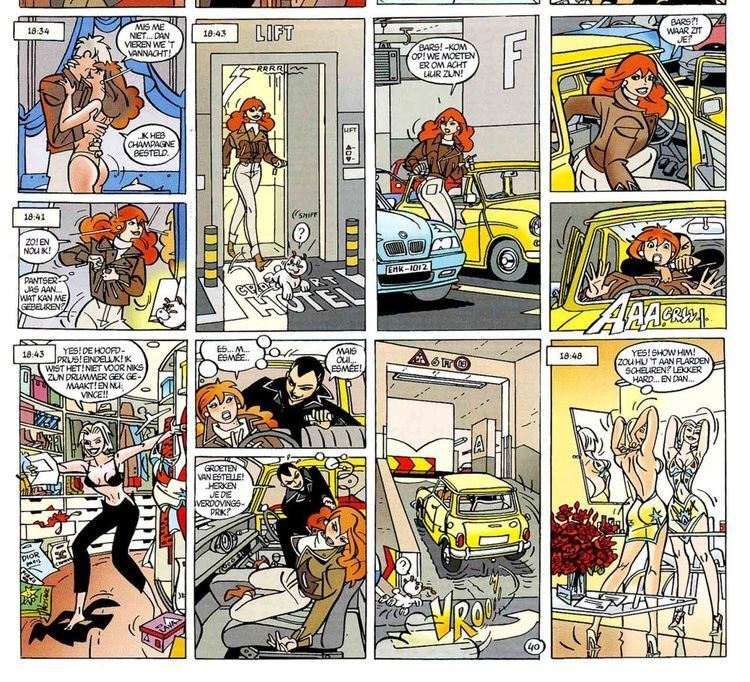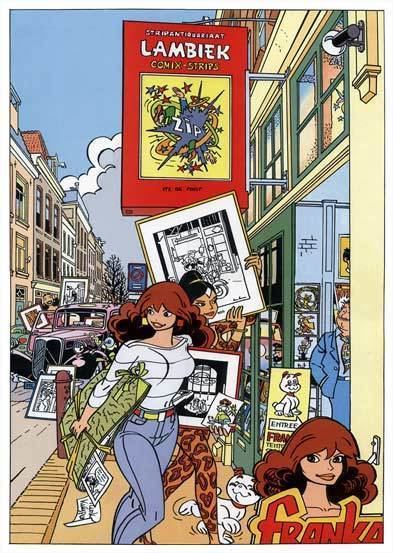 | ||
Similar Agent 327, Isabelle, Les Tuniques Bleues, Blondin et Cirage, Buck Danny | ||
Franka is a popular Dutch comic book series drawn and written since the mid-1970s by the graphic artist Henk Kuijpers. The principal character is a strong female Dutch sleuth who solves mysteries in exotic locales.
Contents
- Principal character
- Drawing style
- Publication history
- Albums in the official series
- Albums not in the main series
- Trivia
- References

Franka has been translated into a variety of languages, including Danish, German, French and Spanish.
Principal character

Franka (Francesca Victoria), the lead character that the series is named after, is a young, attractive and adventurous female private investigator. She lives in a slightly fictionalised version of the Netherlands, and since 1993's Flight of the Atlantis has clearly been revealed as a resident of Amsterdam (before, she lived in the fictional 'Groterdam'). The cases she solves often take place in the worlds of art, antiquities, fashion and film, and also often feature exotic locales full of smugglers, pirates and other shady businessmen.

Dominant women are a recurring theme of the series, similar to other Franco-Belgian comics series such as Yoko Tsuno. A single woman for long time, Franka acquired a male partner and love interest in the later volumes, the reformed art thief Rix. More often than not she is also accompanied by her dog Bars.
Franka was not the main character in the very first adventure of the series (an eight-page story which makes up the first part of Volume #1, Het Misdaadmuseum).
Instead Jarko (who is an increasingly minor character in all later volumes) played the central role, and Franka is only a secretary in the Criminology Museum.
However, by the second (main) story of the first volume, Franka has become a central character, though not yet as exclusively so as in the later volumes.
Drawing style
Franka is an example of the ligne claire style frequently associated with European comics, and Kuijpers' drawing style is noted for its high artistic standards, particularly clarity of line and accurate detail of elements like cars and buildings. The panels often contain additional little interesting or humorous details not relevant to the main storyline.
The style of drawing has developed significantly from the early comics, in which for example the characters had large eyes and squat proportions, to the more realistic figure drawing of the middle volumes to the slightly more stylized, 'fashion-designer' look of the latest issues. Also changed were the visual depiction of females - the Franka of the later volumes is a much more sexual creature than in the early volumes, where she only had friends, but never partners. While the early volumes rarely show nakedness, all volumes play with erotic poses and later volumes show Franka and other characters naked. Sexual acts, however, generally only hinted at, though again, this becomes more explicit in the later volumes.
Publication history
Franka originally appeared in the weekly comic book Pep which, in 1975, merged with Sjors into Eppo. Franka became one of the magazine's fixtures for the next eleven years (1984 being her one sabbatical-year). In 1988 Eppo became Sjors & Sjimmie but it took another year before Franka made her comeback. In 1992 she returned to annual appearances starting at the beginning of the year. After Sjors & Sjimmie (or Sjosji as it was known since 1994) ceased publication in 1999 Franka went on to become the subject of her own online magazine. In February 2009 Eppo was revived as a forthnightly magazine appealing to original readers as well as their offspring; Franka is one of several household names to be included. In January 2010, she was voted Dutch comic strip heroine of all time.
From the 1990s onwards, Franka was also serialised in Veronica Magazine, the magazine of Veronica TV, which with weekly sales of over 1,000,000 was among the most widely circulated Dutch periodicals.
Franka has also been published in German, Spanish, Catalan, Scandinavian languages, as well as in French (Spirou).
Incidents from previous volumes are often referred to in the subsequent ones, although they can be read independently.
Albums in the official series
The following are the Dutch language editions. From volume 1 to volume 8 the publisher was Oberon, from volume 9 to 15, Big Balloon, and from volume 16 Franka BV.
1. Het Misdaadmuseum (Criminology Museum) (1978)
2. Het Meesterwerk (The Masterpiece) (1978)
3. De Terugkeer van de Noorderzon (The Return of the Noorderzon) (1978)
4. De Wraak van het Vrachtschip (The Revenge of the Freighter) (1979)
5. Circus Santekraam (1981) (includes the episode Animal Day).
6. Het Monster van de Moerplaat (The Swamp Monster) (1982)
7. De Tanden van de Draak (The Dragon's Teeth) (1984)
8. De Ondergang van de Donderdraak (The Dragon's Downfall) (1986)
9. Moordende Concurrentie (Murderous Competition) (1990)
10. Gangsterfilm (Gangster Movie') (1992)
11. De Vlucht van de Atlantis (Flight of the Atlantis) (1993)
12. De Blauwe Venus (The Blue Venus) (1994)
13. De Dertiende Letter (The Thirteenth Letter) (1995)
14. Het Portugese Goudschip (The Portuguese Gold Ship) (1996)
15. De Ogen van de Roerganger (The Eyes of the Oarsman) (1997)
16. Succes Verzekerd (Success Guaranteed) (1999)
17. Eigen risico (At Your Own Risk) (2001)
18. Kidnap (2004)
19. Het zwaard van Iskander (The Sword of Iskander) (2006)
20. De Witte Godin (The White Goddess) (2009)
21. Het Zilveren Vuur (The Silver Fire) (2010)
22. Onderwereld (Underworld) (2012)
23. Geheim 1948 (Secret 1948) (2016)
